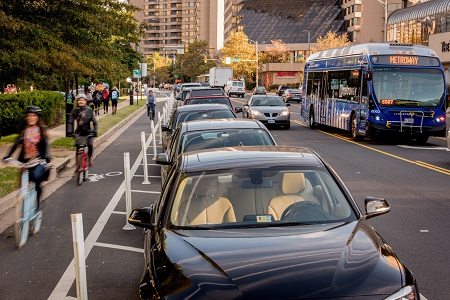The Promise of Complete Streets
New research confirms that when an individual considers a street walk-friendly, they are more likely to walk.
When an individual consider a street “walk-friendly,” they are more likely to walk. This is one of the findings from a new study that sought to evaluate the success of a Complete Street in Salt Lake City, Utah. A Complete Street is designed and operated to enable safe access for all users, including pedestrians, bicyclists, motorists and transit riders of all ages and abilities.
Over 1,200 Complete Street Policies exist in the United States today, including Arlington County. The idea is now over ten years old, and being able to empirically confirm the long-standing hypothesis behind the movement adds strength to its importance.

The Journal of Environmental Research and Public Health published an article in September that examined the relationship between perceived and audited walkability. The goal was to determine the correlation between physical activity and the perceived and objective assessment of walkability on a complete street. In other words, does having a walkable street lead to more walking? The study ended up reaffirming what we already know: thinking that a street is walkable has a strong correlation with with real, measured active walkability indicators as well as actual activity levels.
The study, conducted in Salt Lake City, Utah, surveyed residents living within 1.2 miles of a complete street and tracked their activity via pedometers over the course of a year. Residents used the Neighborhood Walkability Scale to assess their perception of neighborhood design features.
Neighborhood-wide walkability audits were also conducted, using 40 indicators from the Irvine Minnesota Inventory, which measures features of the built environment that affect physical activity, including walking. The research team then compared the qualitative data from the residents and the quantitative data from the audit to the residents’ activity levels.

Key Findings
The study confirmed residents were more likely to engage in active transportation when they lived near complete streets with perceived favorable aesthetics, traffic safety, and lower crime. Residents who lived closer to complete streets viewed traffic hazards as a greater threat to walking and biking, while crime indicators weighed more heavily on residents who lived further away.
While many cities have Complete Street policies in place, many others have yet to benefit. Data from this study has been used to create a model to determine the likelihood of active transportation in the area around a complete street. Communities can use this tool to generate data to support policies and planning efforts that prioritize walkability and active transportation.
Learn More
For more research and articles on how important walkability is to safer, more livable streets, visit our friends at Mobility Lab.
Get Involved and Guest Blog
Contact us at info@walkarlington.com to submit your own blog post. We’d love to feature you!
Sam Kittner/Kittner.com









Comments are closed here.
To prevent spam, comments will be approved before appearing on the post. If you have a comment or question, but do not want it to be published, please email WalkArlington.